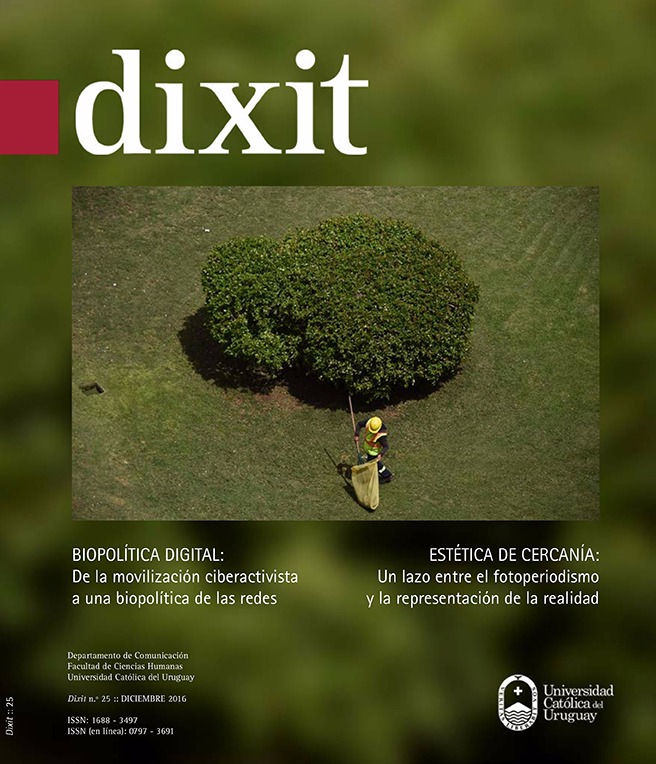The place of the subject in media socialization: between reception and virtual participation
DOI:
https://doi.org/10.22235/d.v0i25.1273Keywords:
socialization, media, social interaction, mediation, cultural anthropologyAbstract
The aim of this article is to reflect on the socializing condition that media have in a context in which coexist the traditional reception and new forms of virtual participation. Taking as starting point the contributions of Alfred Schütz, Albert Bandura, Claudio Esteva Fabregat and Lluís Duch it is evident the need to deepen the concept of media socialization and the key role of subjects. Therefore, it is necessary to adopt a dialectical perspective that integrates the role of humans as mediators and the socializing capacity of media discourses, leaving behind all passive vision of subjects.Downloads
References
Bandura, A. y Walters, R. H. (1974). Aprendizaje y desarrollo de la personalidad. Madrid: Alianza Universidad.
Bandura, A. (2009). Social Cognitive Theory of Mass Communication. Bryant, J. y Oliver, M. B. (Eds.). Media Effects. Advances in Theory and Research (pp. 94-124). Nueva York: Routledge.
Bandura, A. (1962). Social Learning through Imitation. Jones, M. R. (Ed.). Nebraska Symposium on Motivation (pp. 211-269). Lincoln: University of Nebraska Press.
Bandura, A. (1977). Social Learning Theory. Englewood Cliffs: Prentice Hall Publishing.
Barber, N. A. (2014). Investigating the Potential Influence of the Internet as a New Socialization Agent in Context with Other Traditional Socialization Agents. Journal of Marketing Theory & Practice, 21(2), 179-194.
Benedict, R. (1971). El hombre y la cultura: Investigación sobre los orígenes de la civilización contemporánea. Barcelona: Edhasa.
Berger, P. L. y Luckmann, T. (2008). La construcción social de la realidad. Buenos Aires: Amorrortu.
Bonte, P. e Izard, M. (1996). Diccionario de etnología y antropología. Madrid: Akal.
Boulier, D. (1991). Les styles de relation à la televisión. París: Réseaux, Hors Série.
Brim, O. G. (1966). Socialization through the Life Cycle. Brim, O. G. y Wheeler, S. (Eds.). Socialization after Childhood: Two Essays (pp. 1-49). Nueva York: John Wiley & Sons.
Bush, A. J., Smith, R. y Martin, C. (2013). The Influence of Consumer Socialization Variables on Attitude toward Advertising: A Comparison of African-Americans and Caucasians. Journal of Advertising, 28, 13-24. doi: 10.1080/00913367.1999.10673586
Chaffee, S. H., McLeod, J. M. y Walkman, D. B. (1973). Family Communications patterns an adolescents’ political participation. Denis, J. (Ed.). Socialization to Politics: A reader (pp. 349-364). Nueva York: Wiley.
Chapin, J. R. (2000). Adolescent Sex and Mass Media: A developmental Approach. Adolescence, 35, 799-811.
Collins, R. L. (2011). Content Analysis of Gender Roles in Media: Where Are We Now and Where Should We Go?. Sex Roles, 64, 290-298. doi:10.1007/s11199-010-9929-5
Dietz, T. L. (1998). An Examination of Violence and Gender Role Portrayals in Video Games: Implications for Gender Socialization and Aggressive Behavior. Sex Roles, 38, 425-442. doi:10.1023/A:1018709905920
Dill, K. E. y Thill, K. P. (2007). Video Game Characters and the Socialization of Gender Roles: Young People’s Perceptions Mirror Sexist Media Depictions. Sex Roles, 57, 851-864. doi:10.1007/s11199-007-9278-1
Duch, L. (2010). Religió i comunicació. Barcelona: Fragmenta.
Durham, M. G. (1999). Girls, Media and the Negotiation of Sexuality: A study of Race, Class, and Gender in Adolescent Peer Groups. Journalism and Mass Communication Quarterly, 76 (2), 193-216.
Erikson, E. H. (1970). Infancia y sociedad. Buenos Aires: Hormé.
Erikson, E. H. (1972). Sociedad y adolescencia. México: Siglo XXI.
Esteva Fabregat, C. (1993). Cultura, sociedad y personalidad. Barcelona: Anthropos.
Fisherkeller, J. E. (2002). Growing up with Television. Everyday Learnig among Young Adolescents. Filadelfia: Temple University Press.
Freud, S. (1949). An Outline of Psychoanalysis. Nueva York: Norton.
Fujioka, Y. y Austin, E. W. (2002). The relationship of Family Communication Patterns to Parental Mediation Styles. Communication Research, 29, 642-665.
Hartmann, T. y Klimmt, C. (2006). Gender and Computer Games: Exploring Females’ Dislikes. Journal of Computer-Mediated Communication,11, 910–931. doi:10.1111/j.1083-6101.2006.00301.x
Hardin, M. y Greer, J. D. (2009). The Influence of Gender-role Socialization, Media Use and Sports Participation on Perceptions of Gender-Appropriate Sports. Journal of Sport Behavior, 32 (2), 207-226.
Gerbner, G., Gross, L., Morgan, M. y Signorelli, N. (1986). Growing up with television: the cultivation perspective. Bryant, J. y Zillmann, D. (Eds.). Media effects: advances in Theory and Research (pp.17-41). Hillsdale: Lawrence Erlbaum Associates.
Gerbner, G., Gross, L., Signorielli, N. y Morgan, M. (1980) Aging with Television: Images on Televisión Drama and Conceptions of Social Reality. Journal of Communication, 30 (1), 37-47.
Gross, L. (1991). Sexual minorities and the mainstream. Journal of Homosexuality, 21, 19-46. doi: 10.1300/J082v21n01_04
Kardiner, A. (1945). El individuo y su sociedad. México: Fondo de Cultura Económica.
Kohlberg, L. (1992). Psicología del desarrollo moral. Bilbao: Desclée de Brouwer.
Lull, J. (1980). The social uses of television. Human Communication Research, 6, 197-209.
Martín Barbero, J. (1998). De los medios a las mediaciones. México: Gustavo Gili.
Martín Serrano, M. (1987). La mediación social. Madrid: Alianza.
Maturana, H. y Varela, F. (1973). De máquinas y seres vivos: Una teoría sobre la organización biológica. Santiago de Chile: Editorial Universitaria.
Mead, M. (1972). Adolescencia, sexo y cultura en Samoa. Barcelona: Laia.
McDevitt, M. y Chaffee, S. (2000). Closing Gaps in Political Communication and Knowledge: Effects of a School Intervention. Communication Research, 27, 259-292.
Moschis, G. P. y Churchill, G. A. (1978). Consumer Socialization: A Theoretical and Empirical Analysis. Journal of Marketing Research, 15 (4), 599-609.
O’Keefe, G. y Reid-Nash, K. (1987). Socializing Functions. Berger, C. y Chaffee, S. H. (Comps.). Handbook of Communication of Science (pp. 419-445). Newbury Park: Sage.
Ortiz, M. y Harwood, J. (2007). A Social Cognitive Theory Approach to the Effects of Mediated Intergroup Contact or Intergroup Attitudes. Journal of Broadcasting and Electronic Media, 51(4), 615-631.
Pasquier, D. (1996). Teen Series’ Reception: Television, Adolescence and Culture of Feelings. Childhood: A Global Journal of Child Research, 3 (3), 351-373.
Piaget, J. (1948). The Moral Juggement of the Child. Nueva York: Free Press.
Pindado, J. (2003). El papel de los medios de comunicación en la socialización de los adolescentes de Málaga. (Tesis Doctoral). Universidad de Málaga, España.
Pindado, J. (2005). Los medios de comunicación en la socialización adolescente. Telos, 62, 14-20.
Potter, J. (1996). Representing reality. Discouse, rethoric and social construction. Londres: Sage.
Rodríguez, M. (1997). Enculturación y socialización. Aguirre Baztán, Á. (Ed.). Cultura e identidad cultural. Introducción a la antropología (pp. 87-106). Barcelona: Editorial Bardenas.
Sampedro, V. F. (2004a). Identidades mediáticas e identificaciones mediatizadas. Visibilidad y reconocimiento identitario en los medios de comunicación. Revista CIDOB d’Afers Internacionals, 66-67, 135-149.
Sampedro, V. F. (2004b). Identidades mediáticas. La lógica del régimen de visibilidad contemporánea. Sphera Pública, 4, 17-35.
Schütz, A. (1972a). Fenomenología del mundo social. Psicología social y sociología. Buenos Aires: Paidós.
Schütz, Alfred (1972b). La construcción significativa del mundo social. Buenos Aires: Paidós.
Schütz, A. (2003). El problema de la realidad social. Buenos Aires: Amorrortu Editores.
Schütz, A. y Luckmann, T. (2001). Las estructuras del mundo de la vida. Buenos Aires: Amorrortu Editores.
Signorelli, N. (1990). Television’s mean and dangerous world: A continuation of the cultural indicators perspective. Signorielli, N. y Morgan, M. (Eds.). Cultivation analysis: New directions in a media effects research (pp. 85-106). Newbury Park: Sage.
Signorelli, N. (1993). Television and adolescents’ perceptions about work. Youth & Society, 24 (3), 314-341.
Silverstone, R., Hirsch, E. y Morley, D. (1996). Tecnologías de la información y de la comunicación y la economía moral de la familia. Silverstone, R. y Hirsch, E. (Eds.). Los efectos de la nueva comunicación (pp. 319-328). Barcelona: Bosch.
Silverstone, R. (2004). ¿Por qué estudiar los medios?. Buenos Aires: Amorrortu.
Singhal, A., Cody, M. J., Rogers, E. M. y Sabido, M. (2004). (Eds.). Entertainment Education and Social Change: History, Research and Practice. Mahwah, NJ: Lawrence Erlbaum Associates.
Sola-Morales, S. (2013a). Un narcisismo radical. La creación de identificaciones en los espacios virtuales. Alaic. Revista Latinoamericana de Ciencias de la Comunicación, 19, 86-95. Recuperado de http://www.alaic.org/revistaalaic/index.php/alaic/article/view/516
Sola-Morales, S. (2013b) El cuerpo y la corporeidad simbólica como forma de mediación. Mediaciones Sociales. Revista de Ciencias Sociales y de la Comunicación, 12, 42-62. Recuperado de http://pendientedemigracion.ucm.es/info/mediars/MediacioneS12/Indice/SolaMoralesS2013/solamoraless2013.html
Sola-Morales, S. (2013c) La identificación con personajes mediáticos de ficción en la recepción mediática y en la participación virtual. Poliantea. Revista Académica y Cultural Fundación Politécnico Grancolombiano, 9 (17), 109-128. Recuperado de http://journal.poligran.edu.co/index.php/poliantea/article/view/467/429
Sullivan, H. S. (1953). The Interpersonal Theory of Psychiatry. Nueva York: Norton.
Suess, D. et al. (1998). Media use and the relationships of children and teenagers with their peer groups: A Study of Finnish, Spanish and Swiss Cases. European Journal of Communication, 13, 521-538.
Turkle, S. (2005). The Second Self: Computers and the Human Spirit. Cambridge, MA: MIT Press.
Turkle, S. (2011). Alone Together. Why We Expect More from Technology and Less from Each Other. Nueva York: Basic Books.
Wang, X., Yu, C. y Wei, Y. (2012). Social Media Peer Communication and Impacts on Purchase Intentions: A Consumer Socialization Framework. Journal of Interactive Marketing, 26 (4), 198-208. http://dx.doi.org/10.1016/j.intmar.2011.11.004
Walkerdine, V. (1993). Daddy’s gonna buy you a dream to cling to: young girls and popular television. Buckingham, D. (Ed.). Reading Audiences. Young People and the Media (pp. 74-88). Manchester: Manchester University Press.
Weber, M. (1964). Economía y Sociedad. Vol. I. México: Fondo de Cultura Económica.
Wolf, M. (1992). Los efectos sociales de los media. Barcelona: Paidós.
Downloads
Published
How to Cite
Issue
Section
License
From issue number 32 onwards all contents are licensed under the Creative Commons Attribution 4.0 International License (CC BY 4.0).
Issues number 29-31 are licensed under the Creative Commons Attribution-NonCommercial 4.0 International License.
The contents corresponding to number 28 and earlier editions are under the Creative Commons Attribution-NonCommercial-ShareAlike 4.0 International License.


















